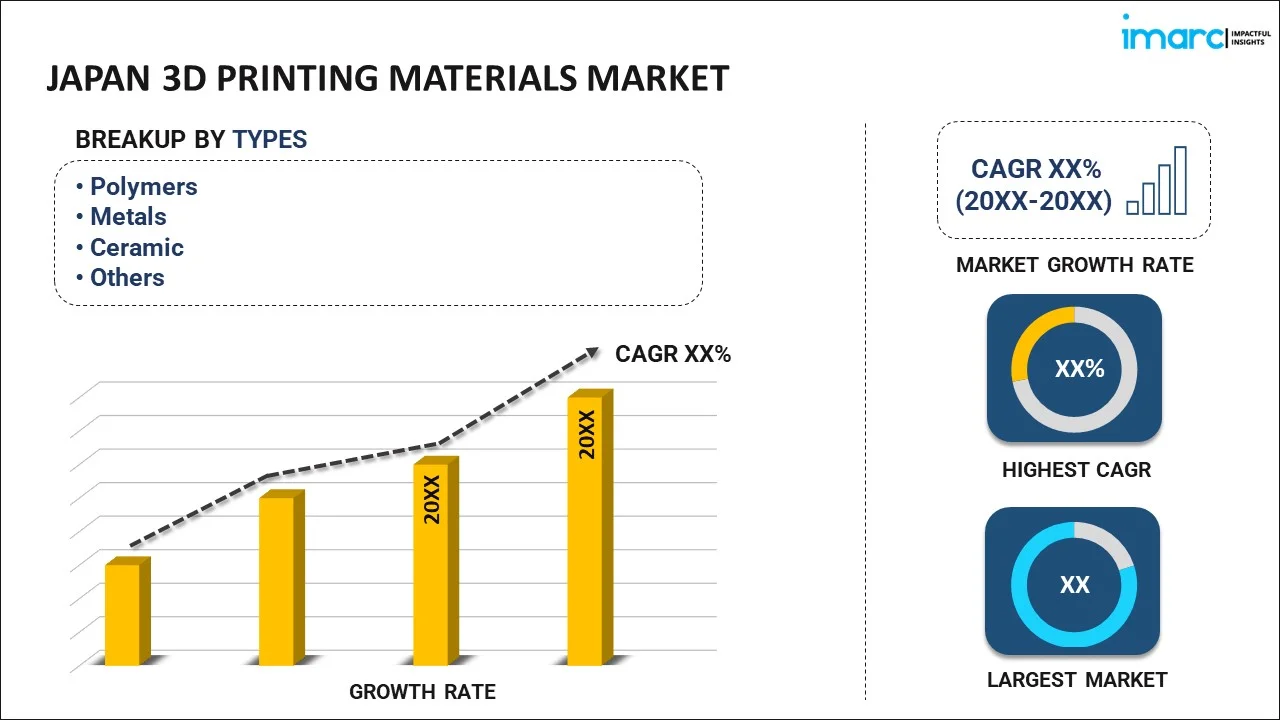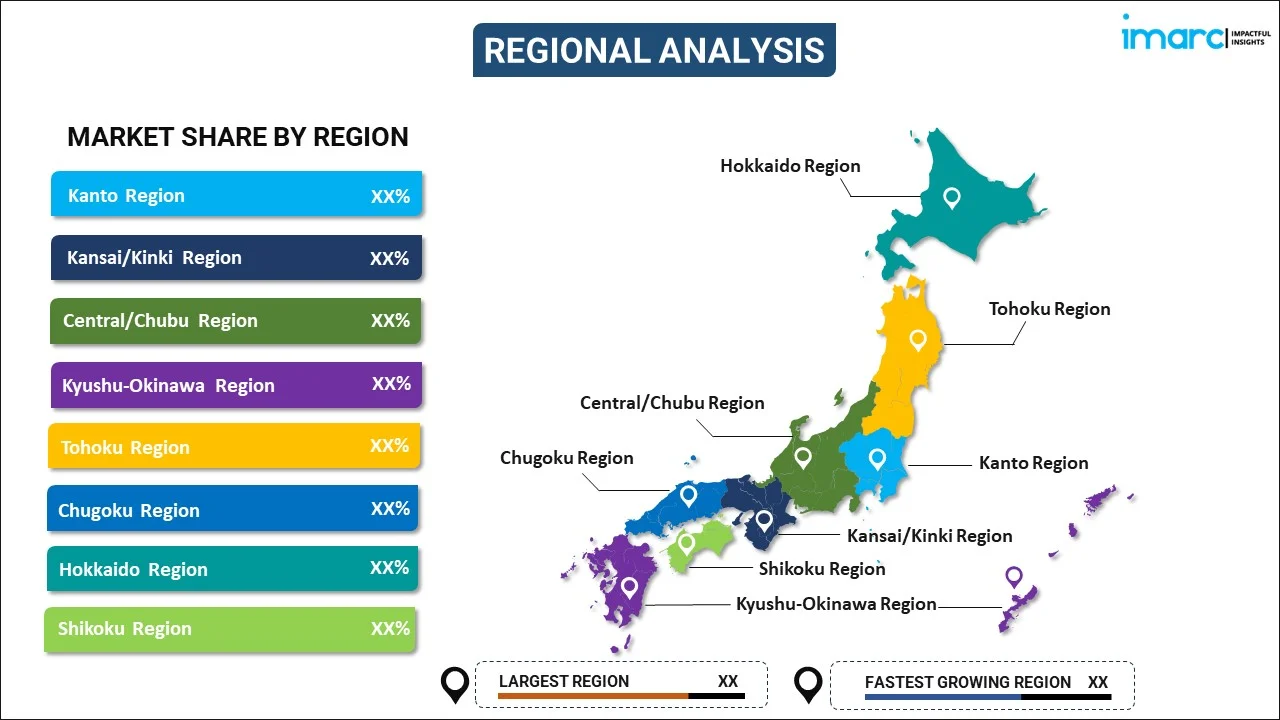
Japan 3D Printing Materials Market Report by Type (Polymers, Metals, Ceramic, and Others), Form (Powder, Filament, Liquid), End User (Consumer Products, Aerospace and Defense, Automotive, Healthcare, Education and Research, and Others), and Region 2025-2033
Market Overview:
Japan 3D printing materials market size reached USD 189 Million in 2024. Looking forward, IMARC Group expects the market to reach USD 804 Million by 2033, exhibiting a growth rate (CAGR) of 17.5% during 2025-2033. The increasing need for 3D printing materials in the industrial domain, the emergence of materials that are safe for medical use and can be sterilized, as well as supportive governmental policies, are primary contributors to market growth.
|
Report Attribute
|
Key Statistics
|
|---|---|
|
Base Year
|
2024 |
|
Forecast Years
|
2025-2033 |
|
Historical Years
|
2019-2024
|
| Market Size in 2024 | USD 189 Million |
| Market Forecast in 2033 | USD 804 Million |
| Market Growth Rate (2025-2033) | 17.5% |
3D printing materials are extensively employed in the additive manufacturing process, offering a diverse range of options for transforming digital designs into physical objects. Among these materials, thermoplastics stand out as one of the most commonly used types. They are melted and shaped using 3D printers, and they boast qualities such as affordability, flexibility, and strength, which contribute to their status as the most favored choice in 3D printing. Additionally, there is a variety of other materials utilized in 3D printing, including metals, carbon fibers, ceramics, and composite materials. Each material possesses its own distinct characteristics, allowing users to tailor their creations to specific requirements. For instance, metal-based 3D printing materials are renowned for their exceptional strength, while carbon fiber and composite materials offer the advantages of reduced weight and enhanced durability. Ceramics are utilized to produce objects with a glossy surface finish, whereas composite materials provide a wide array of colors and textures. Consequently, 3D printing materials have gained widespread popularity across the globe, affording users a multitude of possibilities when it comes to crafting objects from digital designs.
Japan 3D Printing Materials Market Trends:
The surging demand for 3D printing materials within the industrial sector is a predominant force propelling the global market. This surge finds its foundation in the expanding adoption of 3D printing products across a diverse range of industries, encompassing aerospace, healthcare, automotive, and architecture. Furthermore, this widespread acceptance has generated a need for 3D printing materials tailored to meet the precise demands of these sectors. To illustrate, the aerospace industry necessitates lightweight and high-strength materials, while the healthcare sector requires biocompatible and sterilizable materials, thus serving as an additional impetus for growth. Consequently, 3D printing materials are ushering in a transformative era in medicine, facilitating the production of bespoke medical devices, implants, and even organs. This has concurrently driven demand for biocompatible 3D printing materials, those that do not elicit adverse reactions when incorporated into the human body, thus further catalyzing market expansion. In addition to these factors, governments across various nations are actively endorsing 3D printing technology adoption in diverse industries through funding initiatives, tax incentives, and subsidies, thereby elevating global demand. Furthermore, the introduction of innovative 3D printing technologies such as stereolithography (SLA), fused deposition modeling (FDM), and selective laser sintering (SLS) for the development of materials optimized for each technology augments the optimistic market outlook. Continual technological advancements and extensive research and development (R&D) activities also contribute to the overall market growth.
Japan 3D Printing Materials Market Segmentation:
IMARC Group provides an analysis of the key trends in each segment of the market, along with forecasts at the country level for 2025-2033. Our report has categorized the market based on type, form, and end user.
Type Insights:

- Polymers
- Acrylonitrile Butadiene Styrene (ABS)
- Polylactic Acid (PLA)
- Photopolymers
- Nylon
- Others
- Metals
- Steel
- Titanium
- Aluminum
- Others
- Ceramic
- Silica Sand
- Glass
- Gypsum
- Others
- Others
The report has provided a detailed breakup and analysis of the market based on the type. This includes polymers (acrylonitrile butadiene styrene (ABS), polylactic acid (PLA), photopolymers, nylon, and others), metals (steel, titanium, aluminum, and others), ceramic (silica sand, glass, gypsum, and others), and others.
Form Insights:
- Powder
- Filament
- Liquid
A detailed breakup and analysis of the market based on the form have also been provided in the report. This includes powder, filament, and liquid.
End User Insights:
- Consumer Products
- Aerospace and Defense
- Automotive
- Healthcare
- Education and Research
- Others
The report has provided a detailed breakup and analysis of the market based on the end user. This includes consumer products, aerospace and defense, automotive, healthcare, education and research, and others.
Regional Insights:

- Kanto Region
- Kansai/Kinki Region
- Central/ Chubu Region
- Kyushu-Okinawa Region
- Tohoku Region
- Chugoku Region
- Hokkaido Region
- Shikoku Region
The report has also provided a comprehensive analysis of all the major regional markets, which include Kanto Region, Kansai/Kinki Region, Central/ Chubu Region, Kyushu-Okinawa Region, Tohoku Region, Chugoku Region, Hokkaido Region, and Shikoku Region.
Competitive Landscape:
The market research report has also provided a comprehensive analysis of the competitive landscape in the market. Competitive analysis such as market structure, key player positioning, top winning strategies, competitive dashboard, and company evaluation quadrant has been covered in the report. Also, detailed profiles of all major companies have been provided.
Latest News and Developments:
- In January 2025, SOLIZE Corporation stated that it will install a Roboze ARGO 500 HYPERSPEED 3D printing machine at its Toyota Plant, after becoming Japan's official Roboze distributor.
- In October 2024, Asahi Kasei and Aquafil signed a Memorandum of Understanding (MOU). The two businesses decided to develop a new material for 3D printing (3DP) applications by combining Aquafil's Econyl Polymer chemically regenerated PA6 with Asahi Kasei's cellulose nanofibre.
- In July 2024, POLYPLASTICS, a Japanese chemical business, invested in NematX's liquid crystal polymer 3D printing materials. This partnership represents a significant step forward in additive manufacturing (AM), combining POLYPLASTICS' superior polymer knowledge with NematX's unique high-precision extrusion technology.
Japan 3D Printing Materials Market Report Coverage:
| Report Features | Details |
|---|---|
| Base Year of the Analysis | 2024 |
| Historical Period | 2019-2024 |
| Forecast Period | 2025-2033 |
| Units | Million USD |
| Scope of the Report | Exploration of Historical Trends and Market Outlook, Industry Catalysts and Challenges, Segment-Wise Historical and Future Market Assessment:
|
| Types Covered |
|
| Forms Covered | Powder, Filament, Liquid |
| End Users Covered | Consumer Products, Aerospace and Defense, Automotive, Healthcare, Education and Research, Others |
| Regions Covered | Kanto Region, Kansai/Kinki Region, Central/ Chubu Region, Kyushu-Okinawa Region, Tohoku Region, Chugoku Region, Hokkaido Region, Shikoku Region |
| Customization Scope | 10% Free Customization |
| Post-Sale Analyst Support | 10-12 Weeks |
| Delivery Format | PDF and Excel through Email (We can also provide the editable version of the report in PPT/Word format on special request) |
Key Benefits for Stakeholders:
- IMARC’s industry report offers a comprehensive quantitative analysis of various market segments, historical and current market trends, market forecasts, and dynamics of the Japan 3D printing materials market from 2019-2033.
- The research report provides the latest information on the market drivers, challenges, and opportunities in the Japan 3D printing materials market.
- Porter's five forces analysis assist stakeholders in assessing the impact of new entrants, competitive rivalry, supplier power, buyer power, and the threat of substitution. It helps stakeholders to analyze the level of competition within the Japan 3D printing materials industry and its attractiveness.
- Competitive landscape allows stakeholders to understand their competitive environment and provides an insight into the current positions of key players in the market.
Key Questions Answered in This Report
The Japan 3D printing materials market was valued at USD 189 Million in 2024.
The growth of Japan's 3D printing materials market is driven by increasing adoption of additive manufacturing in automotive and aerospace industries, advancements in material innovation, government initiatives supporting Industry 4.0, and rising demand for sustainable and lightweight materials in prototyping and production applications.
IMARC Group expects the market to reach USD 804 Million by 2033, exhibiting a growth rate (CAGR) of 17.5% during 2025-2033.
Need more help?
- Speak to our experienced analysts for insights on the current market scenarios.
- Include additional segments and countries to customize the report as per your requirement.
- Gain an unparalleled competitive advantage in your domain by understanding how to utilize the report and positively impacting your operations and revenue.
- For further assistance, please connect with our analysts.
 Inquire Before Buying
Inquire Before Buying
 Speak to an Analyst
Speak to an Analyst
 Request Brochure
Request Brochure
 Request Customization
Request Customization




.webp)




.webp)












